Camping in Glacier National Park
Planning a visit and searching for lodging or camping in Glacier National Park? Well, we’ve packed this Glacier NP travel blog with lots of good tips for how to find campsites, spot wildlife, and enjoy the views from the Going-to-the-Sun Road!
Road tripping to Glacier National Park and want to camp along the way? Check out Sēkr! It’s a free app that helps you find campsites, read campground reviews, and find dispersed camping. In addition, Sēkr lets you see where there’s wifi, electricity hookups, and cell service!
When to Visit Glacier National Park
Glacier National Park is open year-round, however, the best months for camping in Glacier National Park are June through mid-September. Keep in mind though, this is when most families visit. Therefore you will need to plan ahead by booking your campground or lodging a few months in advance.
We camped in September and some of the more northern campgrounds like Many Glacier were closing due to snow and bear activity! Check out our Road Trip Camping Packing List for a full list of what we brought with us to camp!
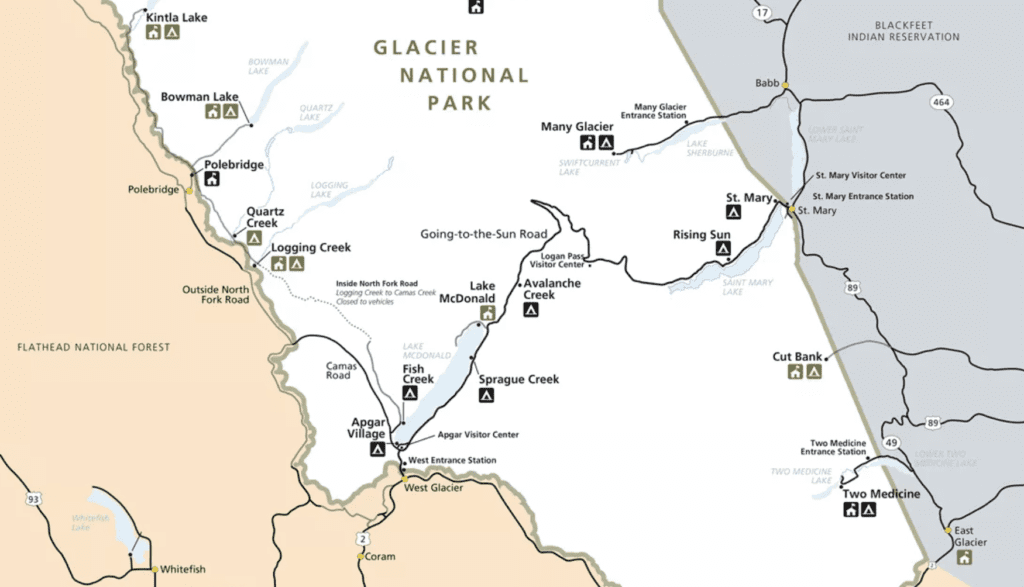
Glacier National Park stretches from West Glacier all the way north, crossing the border with Canada! It’s called Waterton Lakes National Park on the Canadian side.
Bears in Glacier National Park
Before we dive further into camping in Glacier, one of the questions we are always asked? Did you see bears in Glacier National Park? So we wanted to take a bit of time to talk about what you might see, and how to protect yourself and your family.
You will be able to spot both grizzlies and black bears in Glacier National Park. Bears thrive throughout the park, and so an encounter with a black bear or grizzly bear can happen at any time. Anywhere. Bears may appear docile, minding their own business, but can move quickly and can be aggressive. In addition, black bears and grizzlies can run at speeds of up to 35mph! If you don’t believe how fast they can move, just check out YouTube or watch this black bear chase a mountain biker downhill nearby in Whitefish, Montana!
Sightings are rare, however, during our recent trip, read how park rangers had to deal with a curious 4-year-old female black bear that began entering campsites at Many Glacier Campground and stealing food!
Tips on keeping a bear-free campsite and staying bear-aware:
- Use the bear box! Put all items with a scent in the bear box. This includes soaps, lotions, sunscreen, and even water bottles.
- Do not leave cooking utensils, dishes, or stoves on your picnic table at your Glacier campsite. It will guarantee unwanted visitors. And not just a large bear. Squirrels, chipmunks, marmots, and deer will raid your campsite for any items that look and smell like a treat!
- Carry bear spray at all times. Especially when hiking or biking. And, read the NPS Guidelines on how to use bear spray effectively.
- Keep a safe distance from bears if you spot one. Especially if it’s a mother and her cubs. 300ft. is what’s recommended. Resist the urge to approach for a better photo.
If are you reading this and you’re already in the park and forgot to buy bear spray, do not worry. You can buy bear spray at most stores near the park.
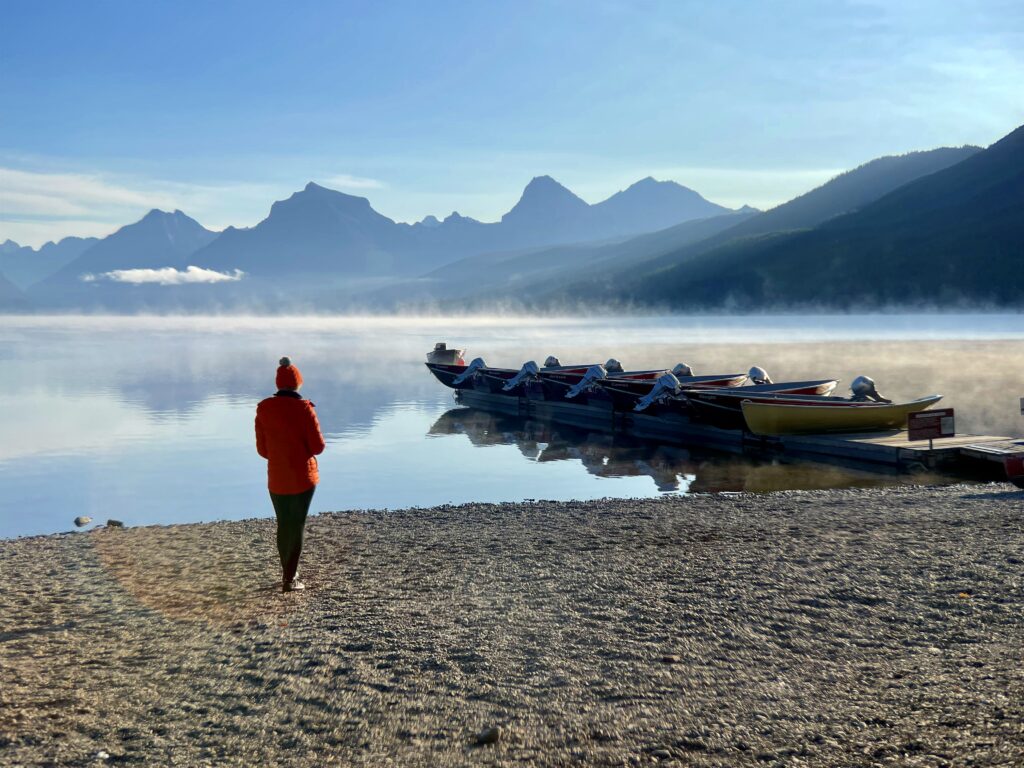
One of the prettiest mornings was waking up at sunrise and watching the clouds rise off Lake McDonald.
Camping with Dogs in Glacier National Park
In addition to grizzly bears, we get asked lots of questions about camping with dogs. Yes, dogs are allowed in Glacier National Park. However, just as in all National Parks, your dog must be leashed at all times.
Dogs cannot leave the pavement. So you cannot hike with your dog to Hidden Lake or Avalanche Creek in the Glacier. However, there are plenty of paved areas around Lake McDonald, Logan Pass Visitor Center, and Saint Mary Lake where you can walk with them.
In addition, dogs cannot be left unattended while camping in Glacier National Park. So if you plan to do lots of hiking each day, maybe leave the pup at home for this trip.
Top 5 things to see and do in Glacier National Park:
1. Drive or Bike the Going-to-the-Sun Road
Going-to-the-Sun Road is the main road you will travel on in Glacier National Park. It begins at Lake McDonald but does not get truly special until you pass both the lake and Avalanche Creek. From here you’ll begin to climb up a giant switchback, with very exposed drop-offs and gorgeous alpine views. It is not a road for large RVs, or for the faint of heart!
To drive from West Glacier to St. Mary, the entire length of the Going-to-the-Sun Road, plan on 2.5-3 hours. Add more time if you plan to stop along the way at places like Packers Roost, Logan Pass Visitor Center, and the Weeping Wall.
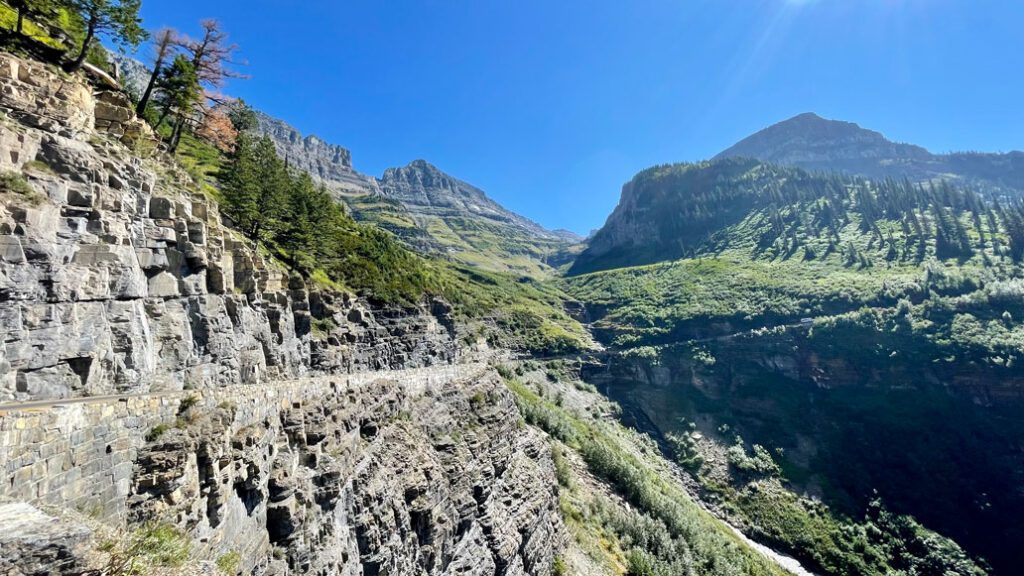
Driving the Going-to-the-Sun Road is not for the faint of heart!
2. Relax and Enjoy the Wildlife in Glacier
Pack binoculars, good hiking shoes, a good camp chair, and be patient. You’ll be about to spot wildlife right from your campground! This is especially true if you camp at Many Glacier where grizzly bears are often present.
You will also spot wildlife, especially mountain goats and big horn sheep, along the Hidden Lake Trail and hiking out to the Granite Park Chalet.
3. Paddle on Lake McDonald or Saint Mary Lake
Lake McDonald and Saint Mary Lake are also the perfect places to spot bears and watch wildlife. Stand-up paddleboarding, kayaking, canoeing, or rent a boat! The shops around Apgar offer plenty of options to enjoy Lake McDonald.
In addition, if you are visiting Saint Mary Lake, head to the Rising Sun picnic area for an easy spot to put in. Bears are also known to frequent this area so always be prepared.
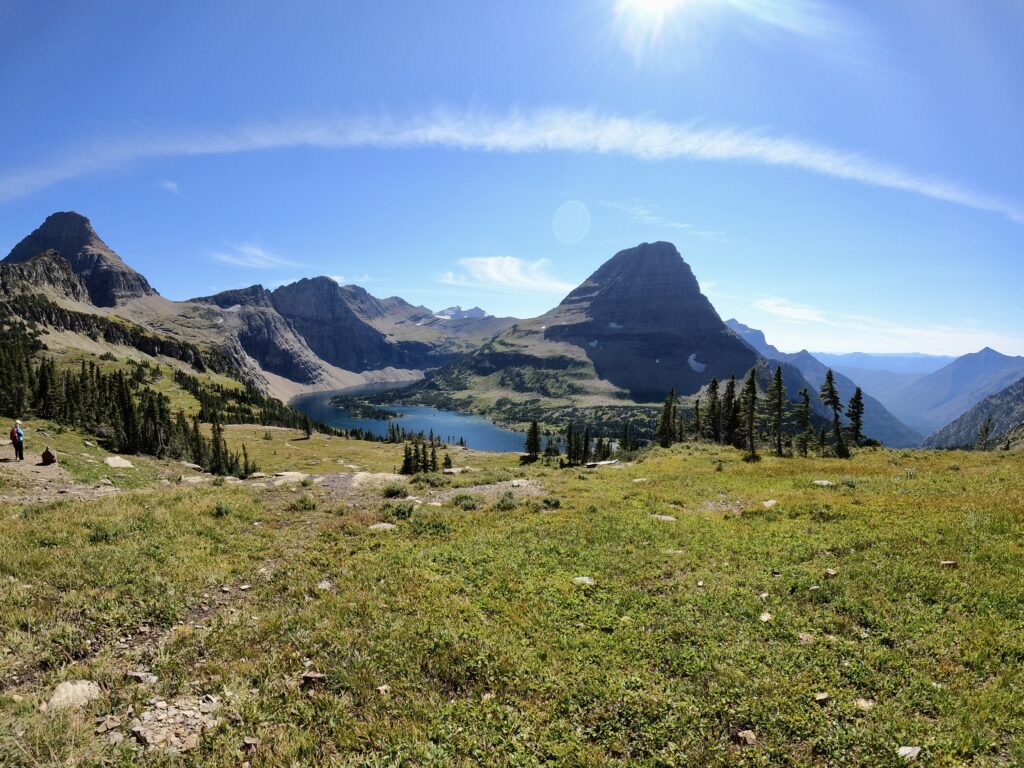
Hike just 30 minutes on some of the trails in Glacier National Park and you’ll be rewarded with gorgeous views of alpine lakes and meadows!
4. Go Hiking in Glacier National Park
There are plenty of hiking trails in Glacier National Park. From alpine meadows to hanging gardens, to glacier-carved valleys, below are a few of our favorite hikes:
Hidden Lake Trail and Hidden Lake Overlook:
To hike Hidden Lake Trail, start at Logan Pass and plan on 1.5 hours if you are only hiking to the Hidden Lake Overlook. 2.5-3 hours if you are hiking all the way down to Hidden Lake.
The full Hidden Lake Trail is 5.4 miles and over 1300ft of elevation gained. You’ll be very exposed on some of the ridges on the descent to the lake. In addition, this is an active bear area. Don’t forget to look for the waterfall at the south end of the trail, and bring your swimsuit to hop in Hidden Lake before the hike back out!
Trail of the Cedars Nature Trail:
This is a very easy, wheelchair-accessible loop that winds through the cedars near Avalanche Creek. It’s less than a mile on either paved or raised wooden planks.
Avalanche Creek Trail:
Avalanche Creek trail follows Avalanche Creek through the tree-covered wilderness to Avalanche Lake. This is a much easier hike than Hidden Lake, with less exposure, not as steep, and 730ft. of elevation gained. Plan on 1.5 to 2 hours to hike the Avalanche Creek Trail. It’s about 4.5 miles in length. Just as with Hidden Lake, this is an active bear area.
Highline Trail:
For those wanting an even bigger challenge than the Hidden Lake Trail, the Highline Trail departs across the road from the Logan Pass Visitor Center and travels over 5 miles deep into the backcountry to the Granite Park Chalet.
At about miles roundtrip to the Granite Park Chalet, with good exposure, and over 2,000ft of elevation gain, the Highline is one of Glacier National Park’s most challenging trails. And it’s only 4 feet wide at some points!
6. Go Fishing
Fishing in the lakes within Glacier National Park is a great way to start or end the day in the park. Fly fishing or hook and line fishing is open year-round, however, all native species caught must be released. And only artificial lures or bait may be used.
Lake McDonald and Saint Mary Lake are great spots for fishing by boat or along the shoreline. And if you camp at Fish Creek, Sprague Creek, Rising Sun, or Apgar campgrounds, you can easily walk down to the lake from your campsite.
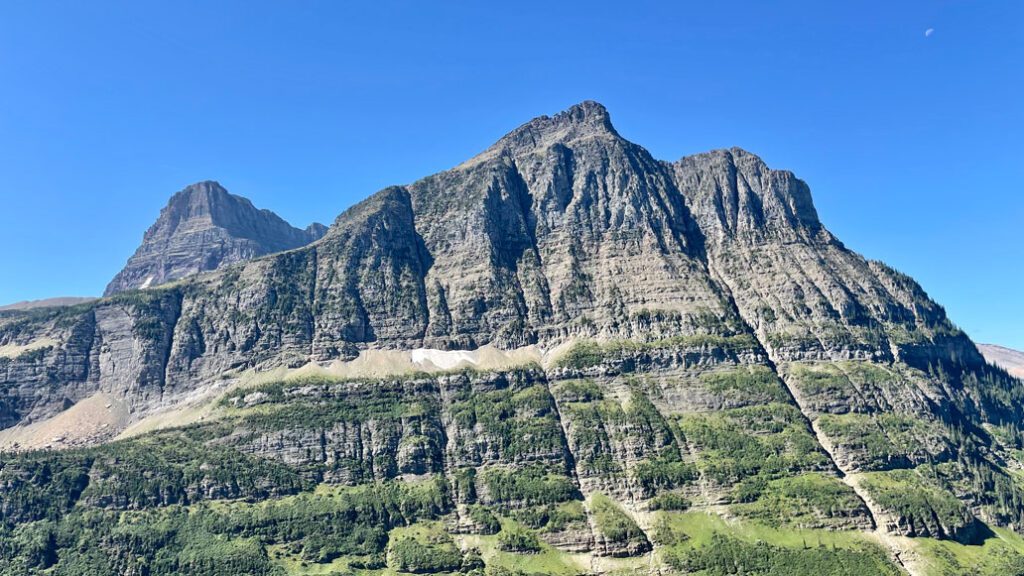
Glacier-carved mountains and valleys are different than those carved by rivers. They can leave behind hanging gardens (check out the Weeping Gardens), moraines (large sediment deposits), and are typically U-shaped vs. V-shaped.
Other activities to fill your Glacier National Park, Montana Vacation:
Mountain Biking or Road Cycling in Glacier
As with most National Parks, trails are primarily designated for hiking in Glacier. However, the Going-to-the-Sun Road is pretty epic by bicycle if you go early in the morning before traffic picks up! In addition, you can ride your road bike through the campgrounds, and back and forth between West Glacier, Apgar, and Fish Creek campgrounds quite easily.
There are no designated mountain bike trails within Glacier, however, there is mountain biking closer to Whitefish, Coram, and Flathead Lake.
Swimming in Glacier’s lakes
A brisk swim at Glacier National Park, with water temperatures rarely above 60 degrees, might be refreshing! In addition, there’s plenty of sandy shoreline along Lake McDonald to hop in.
Don’t forget to wear a lifejacket when you are taking out a boat or paddling! And unfortunately, dogs are not allowed to swim in the lakes and rivers within Glacier National Park.
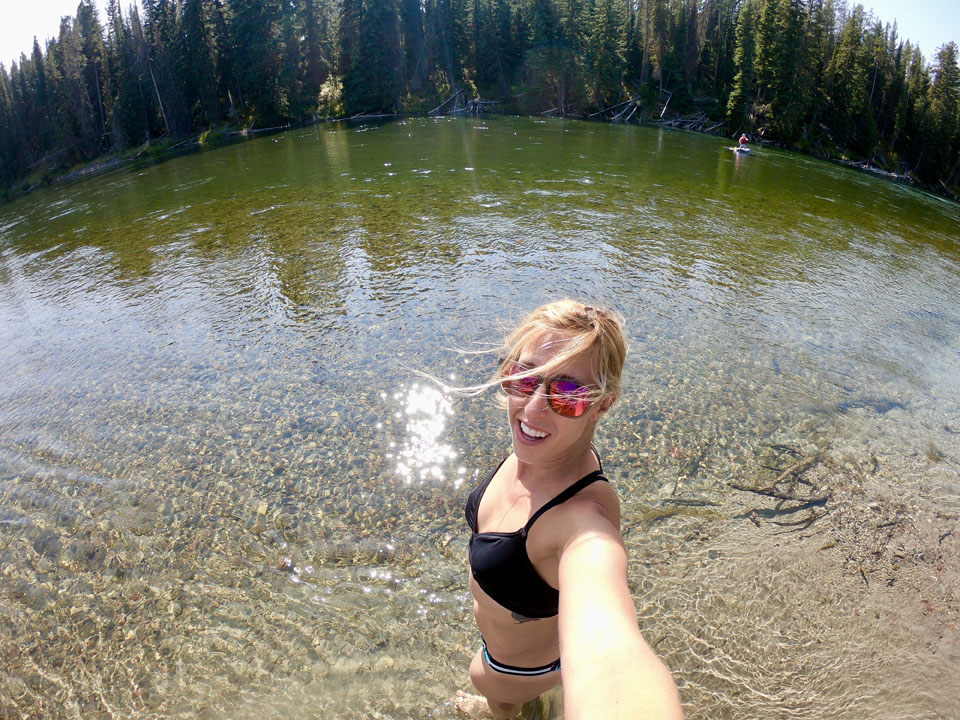
Don’t plan on swimming too long in the lakes and streams, the water is pretty chilly, even in the summertime in Glacier NP!
Where to stay in Glacier National Park
Camping in Glacier National Park
Most camp spots in Glacier National Park will have lots of shade, good flat spots, restrooms nearby, and bear boxes. There are 13 different campgrounds within Glacier NP, from very primitive, to standard tent camping sites, and also electric hookups available for RVs. Here are our favorites:
- Many Glacier– very remote, close to the beautiful Many Glacier Hotel, lots of hiking options, and much more bear activity than other campgrounds.
- Rising Sun– right on Saint Mary Lake, a bit remote
- Avalanche Creek– close to fishing, hiking trails
- Fish Creek– the best spot to score a day-of campsite, with good access to Lake McDonald
- Apgar– closest to lots of shops, boat rentals, Lake McDonald access, restaurants, and lodging
- Sprague Creek- on Lake McDonald, close to Lake McDonald Lodge
To book a campground within Glacier National Park, you can try your luck at a first-come, first-served spot, or use Recreation.gov.
![]()
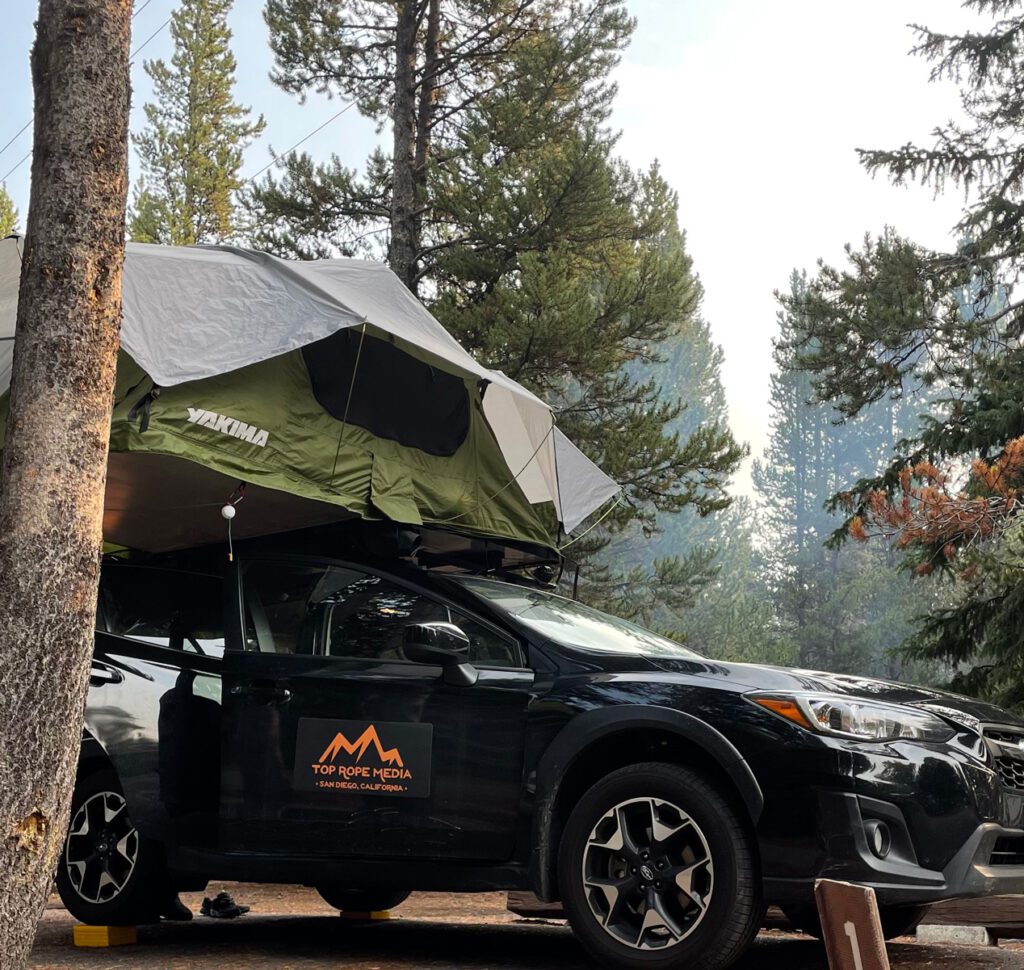
Camping in a tent is more fun if you’re off the ground at Glacier as there are often bears! Watch how easy the Yakima SkyRise Rooftop Tent sets up.
Lodges and Hotels in Glacier National Park
If you do not plan on camping in Glacier National Park, you can book most hotels or lodges through Glacier National Park Lodges and Xanterra. Choose from one of the following:
- Lake McDonald Lodge
- Village Inn Motel
- Many Glacier Hotel
- Rising Sun Motor Inn
- Swiftcurrent Motor Inn
There are also two backcountry chalets you can hike to for overnight accommodations: Sperry Chalet and the Granite Park Chalet.
Last Thoughts for Your Visit to Glacier National Park
Check out our Road Trip Camping Packing List for a list of what we pack! For this trip, even in the summer, plan on lots of layers. Temperatures change rapidly. Thunderstorms are quite common. And morning temps can be in the 40s, even in the summertime! There’s definitely a lot to plan when camping in Glacier National Park, so we hope this gets you excited for an adventure.
Looking for more travel tips?
- Oaxaca, Mexico Travel Guide
- Cuba Libre
- Adventure Travel in Spain
- California’s Eastern Sierras and Yosemite National Park
To learn more about what we do on the regular, follow Top Rope Media’s adventures on Instagram, Facebook, or Twitter.
Until next time, happy camping!
– Meredith McConvill
Recent Comments